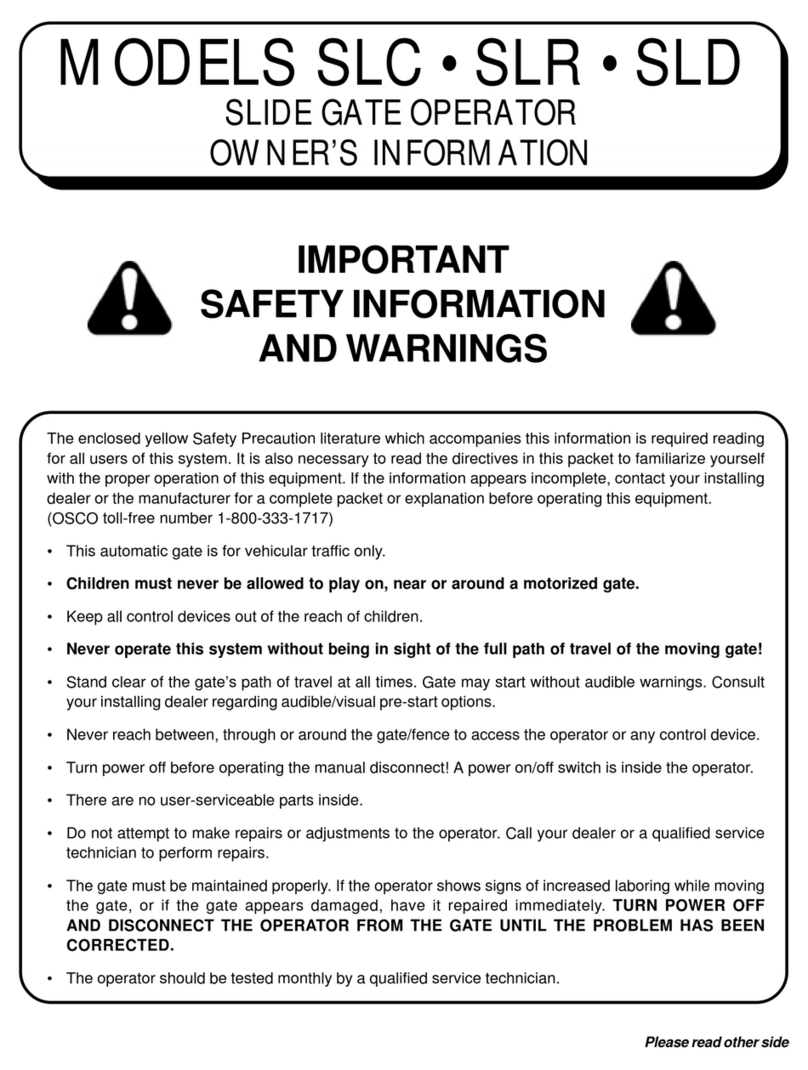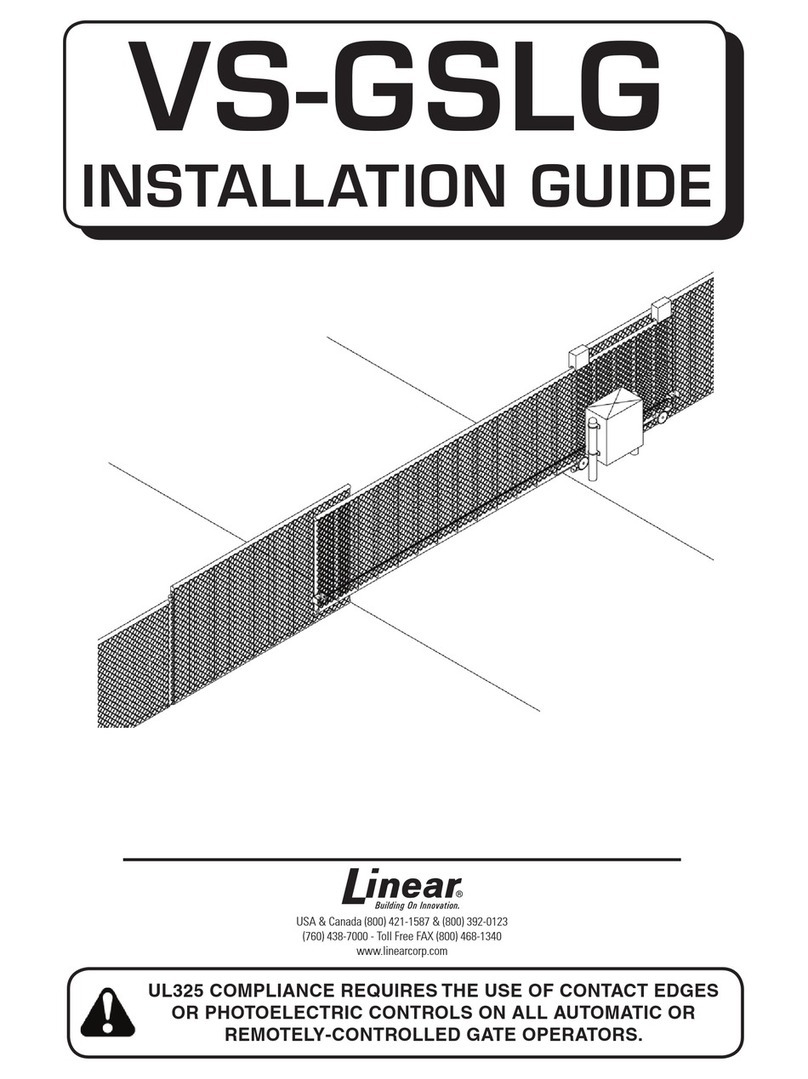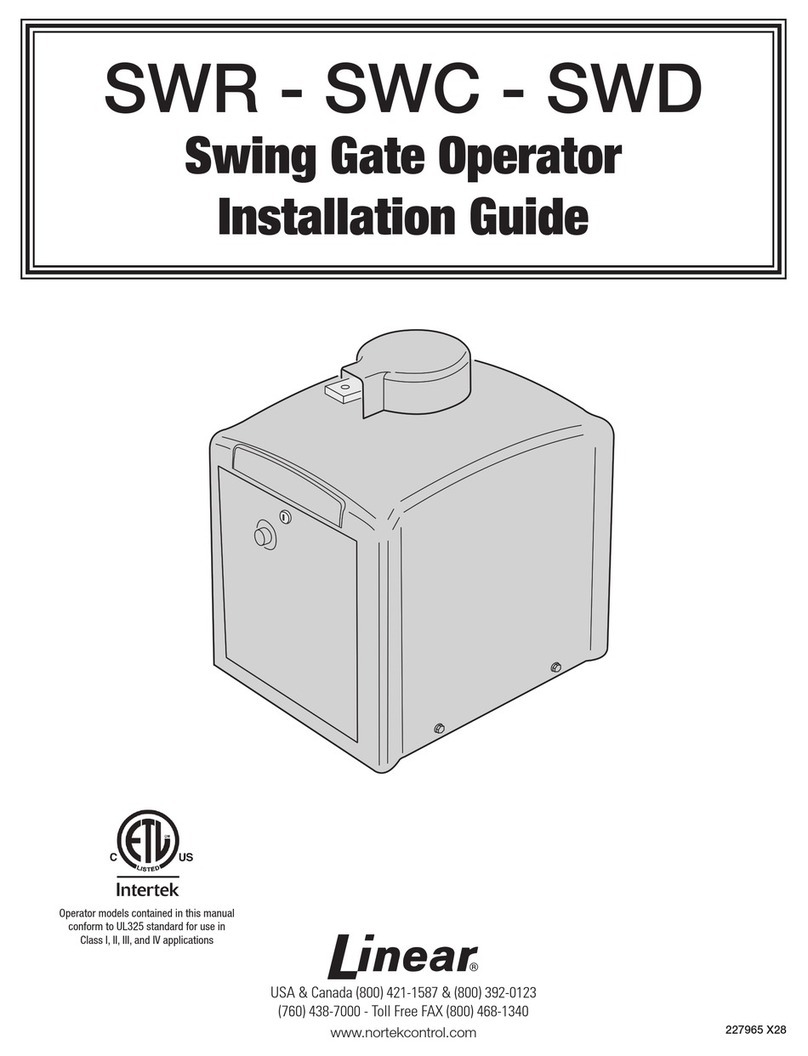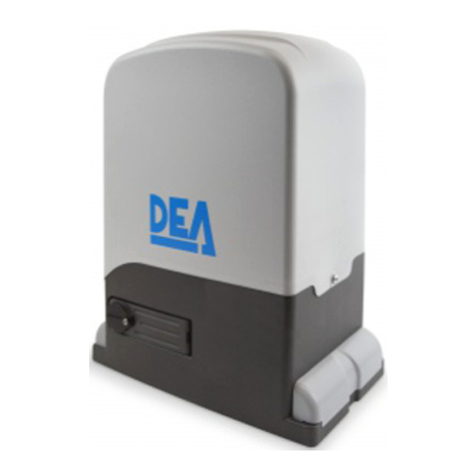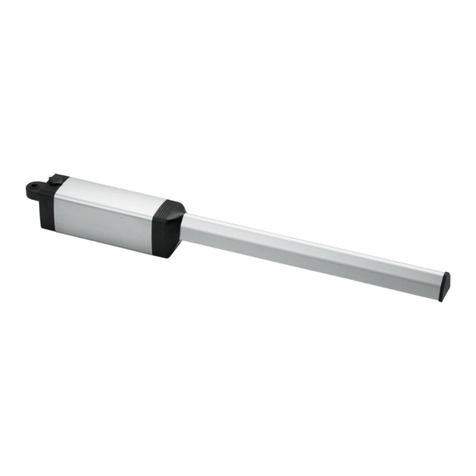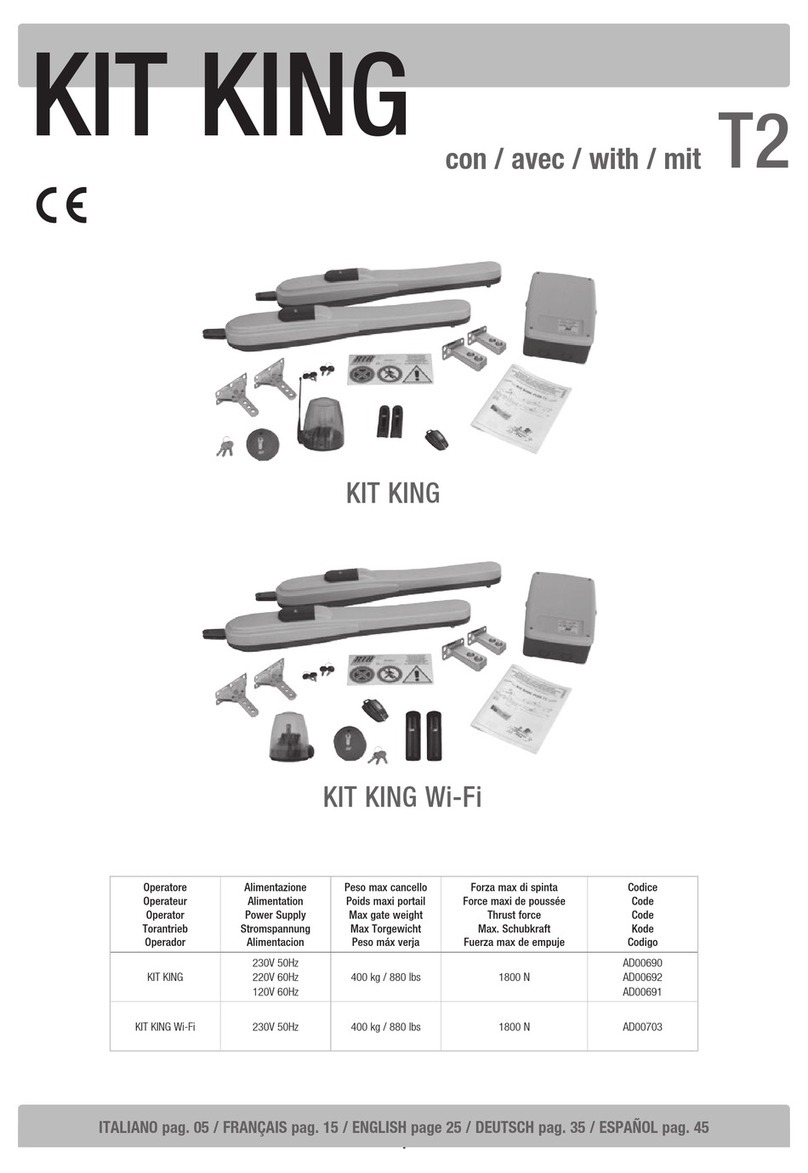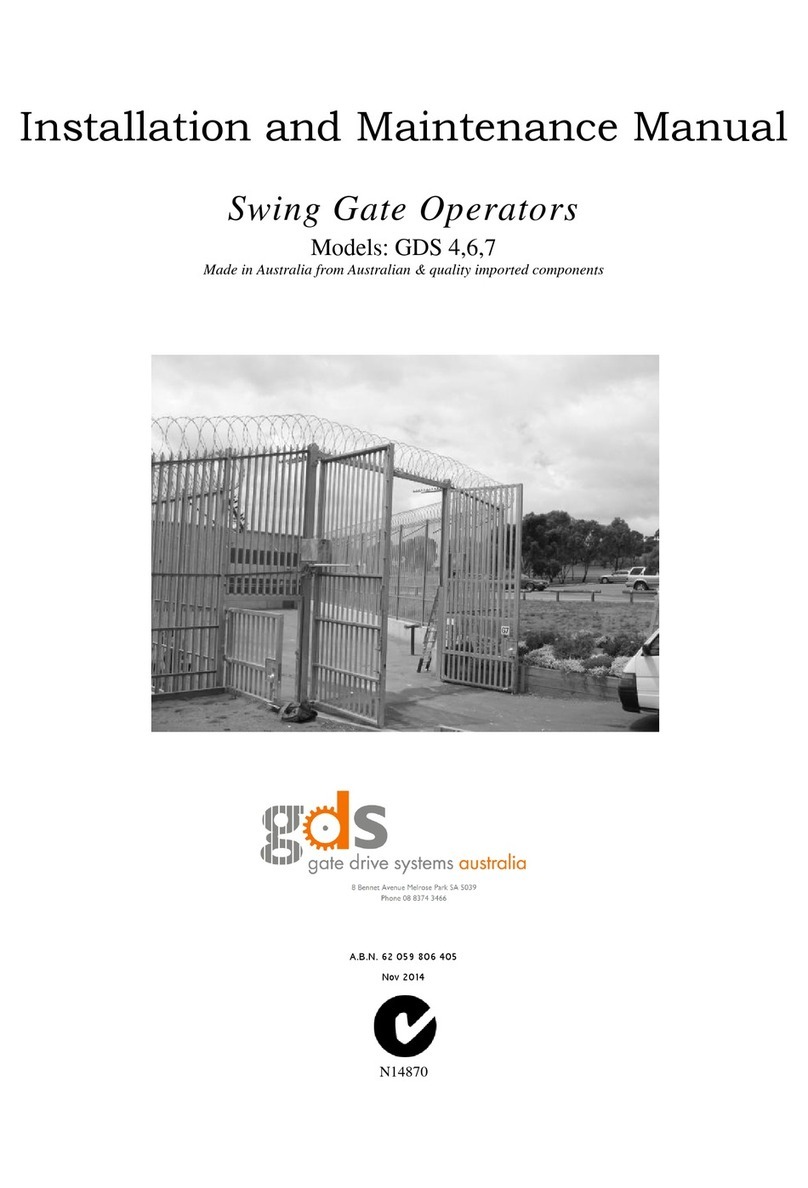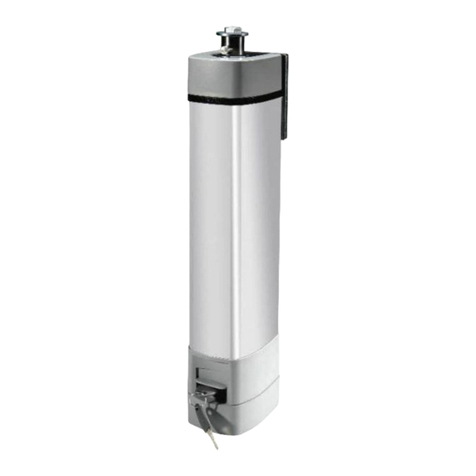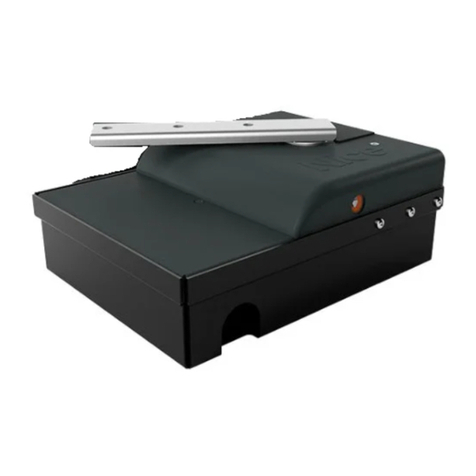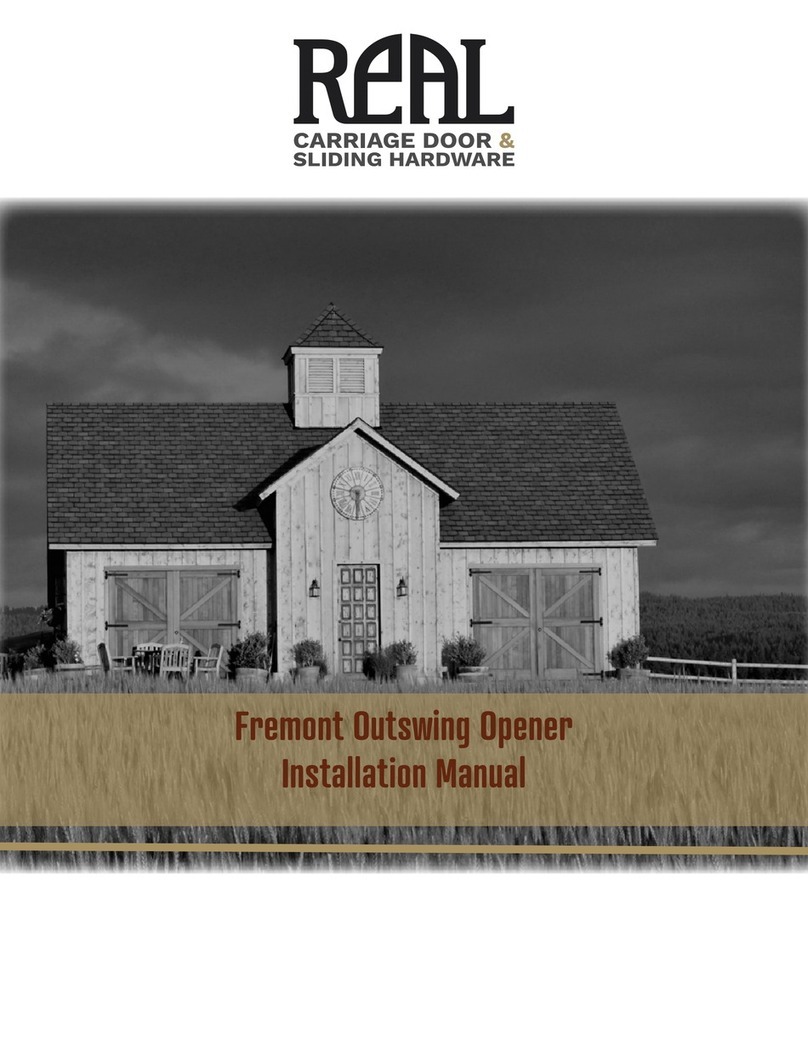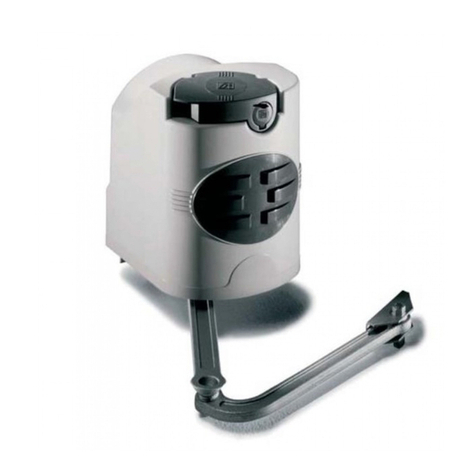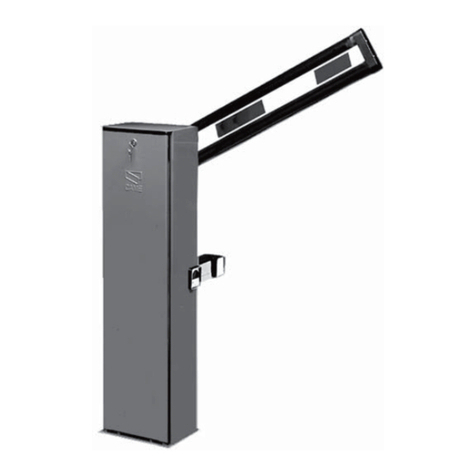Linear SWG User manual

Nov. 2010, Rev. 24
SWG
INSTALLATION GUIDE
UL325 COMPLIANCE REQUIRES THE USE OF CONTACT EDGES
OR PHOTOELECTRIC CONTROLS ON ALL AUTOMATIC OR
REMOTELY-CONTROLLED GATE OPERATORS.
USA & Canada (800) 421-1587 & (800) 392-0123
(760) 438-7000 - Toll Free FAX (800) 468-1340
www.linearcorp.com

SWG OPERATOR INSTALLATION GUIDE
- 2 -
TABLE OF CONTENTS
CAUTION!
DO NOT INSTALL
CONTROLS ON
THE OPERATOR
CAUTION!
ONLY QUALIFIED SERVICE
TECHNICIANS SHOULD
WORK ON AN LINEAR
SWING GATE OPERATOR
CAUTION!
DO NOT INSTALL
CONTROLS ON OR
NEAR THE GATE
PRE-INSTALLATION INFORMATION
Gate Operator Classifications ...................................................................................................................................... 3
Safety Information and Warnings................................................................................................................................. 3
Pre-Installation Information .......................................................................................................................................... 3
Warranty....................................................................................................................................................................... 3
INSTALLATION
Wiring Specifications.................................................................................................................................................... 4
Post Mounting Instructions........................................................................................................................................... 5
String Method for Nonstandard Installation of Swing Gate Operators ......................................................................... 6
Articulating -Style Arm Assembly Instructions .............................................................................................................. 7
Vent Plug Installation.................................................................................................................................................... 8
Torque Limiter Adjustment............................................................................................................................................ 8
Electrical Connection and Adjustments........................................................................................................................ 9
Limit Cam Adjustments ................................................................................................................................................ 9
CONTROL BOARD ADJUSTMENTS and ACCESSORY CONNECTIONS
Control Board Adjustments ........................................................................................................................................ 10
Terminal Connection Descriptions.............................................................................................................................. 11
Current Sensing Adjustments..................................................................................................................................... 12
Close Direction Current Sense Adjustment................................................................................................................ 12
Open Direction Current Sense Adjustment ................................................................................................................ 12
Maximum Run Timer Adjustment ............................................................................................................................... 12
Auto Close Timer Adjustment..................................................................................................................................... 12
Master/Slave Connection ........................................................................................................................................... 12
Onboard L.E.D. Indicator Descriptions....................................................................................................................... 13
Important Notes for Installation of Master/Slave Applications.................................................................................... 14
Surge Protector Instructions....................................................................................................................................... 14
Control and Accessory Connection Illustrations.................................................................................................... 15-18
ILLUSTRATIONS
Loop Layout Illustration .............................................................................................................................................. 19
Edge Layout Illustration #1......................................................................................................................................... 20
Photo Eye Illustration ................................................................................................................................................. 21
TROUBLESHOOTING .................................................................................................................................................. 22
PARTS LISTS
How to Order Replacement Parts .............................................................................................................................. 22
Model SWG Mechanical Parts Exploded View .......................................................................................................... 23
Model SWG Mechanical Parts List............................................................................................................................. 24
Model SWG Single Phase Control Box Exploded View and Parts List ...................................................................... 25
Model SWG Three Phase Control Box Exploded View and Parts List....................................................................... 26
Model SWG Gate Arm Assembly Parts List ............................................................................................................... 27
PREVENTATIVE MAINTENANCE ................................................................................................................................ 29
GATE OPERATOR INSTALLATION CHECKLIST ....................................................................................................... 30

SWG OPERATOR INSTALLATION GUIDE
- 3 -
Read the following before beginning to install Linear swing
gate operators:
1. Read the orange “Safety Instructions” brochure enclosed
with the packet of information. If you do not have one,
please call Linear at 1-800-421-1587 to request one.
Read and follow all instructions.
2. All electrical connections to the power supply must be
made by a licensed electrician and must observe all
national and local electrical codes.
3. A separate power-disconnect switch should be located
near the operator so that primary power can be turned
off when necessary.
4. A minimum of two (2) WARNING SIGNS shall be in-
stalled, one on each side of the gate where easily visible.
5. Never reach between, through or around the fence to
operate the gate.
6. You must install all required safety equipment.
GATE OPERATOR
CLASSIFICATIONS
All gate operators can be divided into one of four different
classifications, depending on their design and usage.
Class I Residential Vehicular Gate Operator
A vehicular gate operator intended for use in a home of one
to four single family dwellings, or garage or parking area
associated with these dwellings.
Class II Commercial / General Access Vehicular Gate
Operator
A vehicular gate operator intended for use in a commercial
location or building such as a multifamily housing unit of five
or more single family units, hotel, retail store or other building
servicing the general public.
Class III Industrial / Limited Access Vehicular Gate
Operator
A vehicular gate operator intended for use in an industrial
location or building such as a factory or loading dock area
or other location not intended to service the general public.
Class IV Restricted Access Vehicular Gate Operator
A vehicular gate operator intended for use in a guarded in-
dustrial location or building such as an airport security area
or other restricted access locations not servicing the general
public, in which unauthorized access is prevented via supervi-
sion by security personnel.
PRE-INSTALLATION
INFORMATION
Before unpacking, inspect the carton for exterior damage.
If you find damage, advise the delivery carrier of a potential
claim.
Inspect your package carefully. You can check your
accessory box parts with the enclosed packing slip for your
convenience. Claims for shortages will be honored for only
30 days from the date of shipment.
Before installing the operator, read this manual completely
to ensure all requirements for proper installation are pres-
ent. Verify that the voltage to be used matches the voltage
of the operator.
SAFETY INFORMATION
AND WARNINGS
IMPORTANT!!
Before installing the gate operator, make sure the gate’s
swing is free and level throughout the entire swing path. If
the gate does not seem to operate properly, it may affect
the operator performance or greatly shorten the life of the
unit. The gate should be designed so that airflow is ample
to prevent wind resistance and drag.
The following contact or non-contact obstruction
detection devices have been approved for use
with Linear slide gate operators as part of a UL325
compliant installation:
Contact Edges:
Miller Models*: MG0-20, MGR-20, MGS-20, and ME-120
Photoeyes:
2520-441 MMTC Model IR-55 photoeye, 165’ with
mounting hardware
2520-031 MMTC Model E3K photoeye, 28’ with
mounting hardware
*for Linear part numbers, contact a sales representative for details

SWG OPERATOR INSTALLATION GUIDE
- 4 -
USE COPPER WIRE ONLY!
ACCESSORY WIRING
All Models
24VDC
*Over 350 ft. use DC power.
0-2000
14
24VAC
250
350*
14
12
Volts
Maximum
Distance (ft.)
Wire
Gauge
1. Select from the chart at the bottom of this page corresponding to the
model, voltage and horsepower rating of your operator.
2. The distance shown on the chart is measured in feet from the operator
to the power source. DO NOT EXCEED THE MAXIMUM DISTANCE.
These calculations have been based on standard 115V and 230V sup-
plies with a 10% drop allowable. If your supply is under the standard
rating, the runs listed may be longer than what your application will
handle, and you should not run wire too near the upper end of the chart
for the gauge of wire you are using.
3. When large-gauge wire is used, a separate junction box (not supplied)
may be needed for the operator power connection.
4. All control devices are now 24VDC, which can be run considerable
distances. 24VAC is available for other devices, such as loop detectors
and photo eyes.
5. Wire run calculations are based on the National Electrical Code, Article
430 and have been carefully determined based on motor inrush, brake
solenoids, and operator requirements.
WIRING SPECIFICATIONS
6. Connect power in accordance with local codes. The green ground
wire must be properly connected.
7. Wire insulation must be suitable to the application.
8. Control wiring must be run in a separate conduit from power wiring.
Running them together may cause interference and faulty signals in
some accessories.
9. Electrical outlets are supplied in all 115VAC models for convenience
with occasional use or low power consumption devices only. If you
choose to run dedicated equipment from these devices, it will decrease
the distance for maximum run and the charts will no longer be accurate.
10. A three-wire shielded conductor cable is required to connect master
and slave operators. You must use Belden 8760 Twisted Pair Shielded
Cable (or equivalent) only – Linear part number 2500-1982, per foot).
See page 10 for details of this connection, as well as dip switch se-
lection. Note: The SHIELD wire should be connected in both the
master and slave operators.
MODEL SWG – SINGLE PHASE
gniriWrewoP
stloV
PH&
ecnatsiDxaM
lauDelgniS
eriW
eguaG
stloV
PH&
ecnatsiDxaM
lauDelgniS
eriW
eguaG
stloV
PH&
ecnatsiDxaM
lauDelgniS
eriW
eguaG
V511
2/1
PH
222
453
665
009
0341
111
771
382
054
517
21
01
8
6
4
V802
2/1
PH
067
0021
4291
0603
4684
083
006
269
0381
2342
21
01
8
6
4
V032
2/1
PH
498
2241
4622
0063
4275
744
117
2311
0081
2682
21
01
8
6
4
V511
4/3
PH
871
282
054
617
0411
98
141
522
853
075
21
01
8
6
4
802
4/3
PH
406
859
6251
4242
6583
203
874
367
2121
8291
21
01
8
6
4
V032
4/3
PH
017
8211
6971
2582
8354
553
465
898
6241
9622
21
01
8
6
4
V511
PH1
061
452
604
646
6201
08
721
302
323
315
21
01
8
6
4
V802
PH1
445
468
4731
4812
6743
272
234
686
2901
8371
21
01
8
6
4
V032
PH1
046
6101
6161
0752
0904
023
805
808
5821
5402
21
01
8
6
4
esahP3:gniriWrewoP
stloV
PH&
ecnatsiDxaM
lauDelgniS
eriW
eguaG
stloV
PH&
ecnatsiDxaM
lauDelgniS
eriW
eguaG
stloV
PH&
ecnatsiDxaM
lauDelgniS
eriW
eguaG
V802
2/1
PH
2411
6181
0982
175
809
5441
21
01
8
V032
2/1
PH
4431
7312
0043
276
9601
0071
21
01
8
V064
2/1
PH
1483
6016
2179
1291
3503
6584
21
01
8
V802
4/3
PH
029
4641
0332
064
237
5611
21
01
8
V032
4/3
PH
4801
3271
1472
245
268
1731
21
01
8
V064
4/3
PH
9723
2125
1928
0461
6062
6414
21
01
8
V802
PH1
417
6311
4081
753
865
209
21
01
8
V032
PH1
048
6331
4212
024
866
2601
21
01
8
V064
PH1
9862
4724
8976
5431
7342
9933
21
01
8
MODEL SWG – THREE PHASE

SWG OPERATOR INSTALLATION GUIDE
- 5 -
POST MOUNTING INSTRUCTIONS FOR MODEL SWG
23” SPACE REQUIRED BEHIND OPERATOR
FOR ARM CLEARANCE WHILE OPENING
IF NONSTANDARD MOUNTING IS NECESSARY,
CONSULT THE FACTORY
Use two 3 - 3 1/2” diameter galvanized posts and secure with concrete
footings as shown, length to be determined by local codes, frost line
depth, and soil conditions.
Attach the operator with the U-bolts, side plates and hardware pro-
vided. There are four side plates. The 3/16” side plates go on the inside
top of the operator, while the two 1/2” side plates go on the inside
bottom (see the illustration at right). The operator should be positioned
at a level to allow the arm to be installed at mid-height on the gate.
“H” dimension can vary depending on gate construction. Make sure
the posts do not protrude above the operator cabinet.
Assemble the arm components as shown on page 7.
NOTE: Maximum gate opening
angle is approximately 95 degrees,
depending on gate width. If larger
opening angle is required, non-
standard positioning of the opera-
tor and modified articulating arms
will be required. Contact the factory
for pricing and availability.
DOOR MUST
FACE AWAY
FROM
DRIVEWAY
SIDE PLATE INSTALLATION
The operator is intended for installation only on
gates used for vehicles. Pedestrians must be sup-
plied with a separate access opening. The pedestrian
access opening shall be designed to promote pedes-
trian usage. Locate the gate such that persons will
not come in contact with the vehicular gate during
the entire path of travel of the vehicular gate.

SWG OPERATOR INSTALLATION GUIDE
- 6 -
STRING METHOD FOR NONSTANDARD INSTALLATION OF SWING GATE
OPERATORS
Step A: Position the Operator
1. Connect the gate plate assembly onto the gate at the recommended
location for a standard installation (Dimension “W”).
2. Open the gate to its fully-open position.
3. Position the operator parallel to the gate. The distance from the op-
erator output shaft to the gate plate pivot point is shown at right. The
operator should be positioned the same distance from the gate hinge
as the gate plate has been; ie: the “W” dimension.
Step B: Measure the Crank Extension and Link Center to Center
Distances
1. Close the gate.
2. Using a piece of tape, attach a string to the top of the operator output
shaft, at its center. Holding the string taut and using another piece of
tape, hold the other end of the string across the hole in the gate plate.
This distance is Dimension 1. Carefully measure this dimension and
write it down.
3. Open the gate.
4. Pick up the string, while it is still attached at both ends, and pull it taut
again while positioning it directly over the center of the operator shaft,
at Point “B,”and work your way back along the string until you reach
Point “C.”
5. While holding the string taut, measure the distance from Point “B” to
Point “C.”This is the required center to center distance for the crank
extension.
6. Measure the distance from Point “A” to Point “C.”This is the required
center to center distance for the link section.
7. When added together, the distances from Point “A” to Point “C” and
Point “B” to Point “C” should equal the Dimension 1measurement.
DOOR MUST
FACE AWAY
FROM
DRIVEWAY
These measurements will be needed when placing an order for special
length crank extensions and links. Also note that the measurements
you have just calculated are center to center only, and are not overall
dimensions, which would also include other attachment hardware, such
as gate arm clamps.
It is also possible that both open and closed limit switches may be acti-
vated at either end of gate travel due to the total gate travel required, and
the shape of the limit switches and cams. This problem can be corrected
by carefully bending the limit switch arm slightly and readjusting its cam.
PLEASE NOTE: Your operator may look different when installed.
The drawings on this page are for general reference only.

SWG OPERATOR INSTALLATION GUIDE
- 7 -
ARTICULATING-STYLE ARM ASSEMBLY INSTRUCTIONS FOR MODEL
SWG
NOTE: Illustrations shown on this page are for right-hand application.
For left-hand, overtravel stop (9) should be on the opposite side from what is shown above.
Numbered items in these
drawings are for instruc-
tional reference only. For
actual part numbers, go to
the parts lists in the back of
this booklet.
Place the crank extension (2) on the operator crank
(1) as shown. Slide a black spacer (3) into the crank
and hold it while sliding a 1/2-13 x 1 3/4” hex head
bolt (4) through the extension and crank. Assemble
with a 1/2” flat washer and locknut and tighten. Slide
the clevis pin (5) and a 1/2” flat washer through
the crank and the extension. Slide another 1/2”
flat washer over the end of the pin and lock it with
either a disconnect pull pin or with an optional pad
lock through the pin.
Angle iron (not supplied) (13) should be welded to the gate
prior to this step. Attach the gate plate (12) to the angle
iron using 3/8 bolts, flat washers, lock washers and hex
nuts (15). Slide a 1/2-13 x 1 1/4” bolt, 1/2” lock washer, 1/2”
flat washer (14), and a black spacer (3) through the gate
plate. Place a nylon washer (8) over the opening in the
gate plate. Thread the bolt into the hole in the gate clamp
(6) and tighten carefully. Do not overtighten! Tighten set
screw (19) to further lock hex bolt (14) in place.
Slide the pipe link (16) through the arm assembly as shown.
Place the 5/16” square bolts in the gate clamps (17) and
tighten carefully. Do not overtighten!
Slide a 1/2” lockwasher and flatwasher onto the 1/2-13 x
2 1/2” hex head bolt (10). Add a nylon washer (8), then
slide the bolt through the crank extension (2) and hold in
place Next, insert the yellow-plated pivot spacer (11) into
the crank extension, add a nylon washer (8) and place the
offset spacer (7) on top of the nylon washer. Add a nylon
washer (8) to the top of the offset spacer (7) and add the
silver zinc-finish overtravel stop spacer (18). Slide the over-
travel stop bracket (9) over the silver zinc-finish spacer and
add the last nylon washer (8) above the bracket. Carefully
screw the bolt assembly into the aluminum gate clamp (6)
until the lockwasher has been fully compressed. The over-
travel stop and crank extension should float freely, without
binding, when it is fully assembled. Tighten set screw (19)
to further lock hex bolt (10) in place.

SWG OPERATOR INSTALLATION GUIDE
- 8 -
TORQUE LIMITER ADJUSTMENT
MODEL SWG
LOCKING TAB
ADJUSTMENT NUT
VENT PLUG INSTALLATION
Gear reducers used in Linear gate operators will have solid plugs installed prior to shipment in order to keep the oil inside
from spilling out during shipping. A vent plug has been provided to replace this plug during installation. This plug will look
similar to the ones shown below. Some models may have a vent plug with a breather pin. This pin should be removed after
installing the operator.
OR
Before adjusting the torque limiter, make sure the gate is
in good working condition. One person should be able to
move the gate by hand. Be certain the gate moves freely
and without binding throughout its travel. Torque limiters are
set light at the factory. They must be adjusted during instal-
lation, preferably after limit cams have been manually set
(see page 9). Adjust the torque limiter tight enough to keep
it from slipping during normal operation.
To adjust the torque limiter in model SWG:
1. Bend the locking tabs away from the adjustment nut.
2. To increase the output, turn the adjustment nut clock-
wise one flat, or 1/6 turn, at a time until desired output
is obtained.
To reduce the output, turn the adjustment nut counter-
clockwise one flat, or 1/6 turn, at a time until desired
output is obtained.
3. Bend the locking tabs up to lock the adjustment nut in
place.

SWG OPERATOR INSTALLATION GUIDE
- 9 -
ELECTRICAL CONNECTION AND ADJUSTMENTS
All Linear gate operators are supplied with a power disconnect switch to turn on and off the power supply available to the
operator. Incoming power should be brought into the operator and connected to the labeled pigtails in the disconnect box,
following wiring specifications on page 4. A wiring connections print can be found on the inside cover of the operator.
Proper thermal protection is supplied with the operator. The motor contains a thermal overload protector to protect from
overheating the motor due to overload or high-frequency operation. This overload will reset automatically after the motor
cools down.
LIMIT CAM ADJUSTMENTS
The limit cams are not preset at the factory and must be adjusted for the length and opening angle of the gate the operator
is installed on. The limit switches are activated by a series of rotating limit cams which are attached to the drive shaft. The
operator has also been preset in the right hand operation mode. If the installation requires left hand operation a dip switch
must be flipped (see page 10).
With the gate connected to the gate operator in a mid-travel position, the power disconnect switch turned OFF, and the torque
limiter set loose enough to slip freely, manually move the gate to its fully open position.
Once the gate is in the fully open position, adjust the limit cam for open direction. Set the LSO-1 limit cam so that it has just
triggered its switch.
Once the open limit cam is set, repeat the above process for the close direction, LSC-1.
After finishing the initial limit cam adjustments, reposition the gate to approximately the center of travel. At this time, adjust
the torque limiter as explained on page 8. Turn the power disconnect switch ON, stand clear of any moving parts and press
the OPEN button. Observe the gate as it runs through a complete cycle in both directions, and adjust your limits again if
necessary.If the operator stops during travel, you may need to adjust the open or close current sensor adjustment or the
maximum run timer (see page 12).
Power supply must be of correct voltage and phase.
Always disconnect power from operator before servicing.
Keep clear of gate during operation.
POWER DISCONNECT BOX
(115VAC VERSION SHOWN)
L1
(WHITE)
L2
(BLACK)
GROUND
(GREEN)
LIMITS and CAMS
MODEL SWG
FROM TOP TO BOTTOM:
LEFT HAND RIGHT HAND
LSC-1 LSO-1
LSO-1 LSC-1
WHENEVER HAND OF OPERATION CHANGES, BOTH LIMIT CAMS WILL
NEED TO BE ADJUSTED.

SWG OPERATOR INSTALLATION GUIDE
- 10 -
Auto Close Timer Adjustment: This 270-degree adjustable potentiometer will signal the operator to close automatically,
provided no open, reversing or obstruction signals are present from the fully-open position. This timer is adjustable from 0
to 124 seconds. This feature is turned on or off using dip switch #1.
Maximum Run Timer Adjustment: This 270-degree adjustable potentiometer will signal the operator to stop running once
it counts down, unless a limit switch is reached or an input is received first. Each time the motor starts, this timer will begin
counting. This timer is adjustable from 15 to 100 seconds. If the timer expires, the unit locks out and the emergency alarm
sounds.
Open Direction Current Sense Adjustment: This multiturn potentiometer is used to calibrate the built-in current sensing
feature for detection of obstructions while running in the open direction.
Close Direction Current Sense Adjustment: This multiturn potentiometer is used to calibrate the built in current sensing
feature for detection of obstructions while running in the closed direction.
Master/Slave Connection Block: This terminal block is used in conjunction with two operators to configure two gates to
open and close together.
Dip Switches:
#1 This switch turns the auto close timer off/on.
#2 This switch is used in conjunction with alarms and flashing lights that may be added to the operator. When the switch
is in the ON position, these devices will start approximately two seconds prior to the operator starting. In the OFF
position, the devices will only work while the operator is running.
#3 This switch is used in conjunction with single-button controls and radio receivers. In the ON position, successive inputs
will cause signals in the order of OPEN-STOP-CLOSE-STOP. In the OFF position, inputs will cause an OPEN signal
unless the gate is fully open, in which case it will signal CLOSE.
#4 This switch determines right-hand vs. left-hand behavior. When looking from inside the protected area toward the gate,
the side of the drive the operator is on determines its hand of operation. In the OFF position, the operator is set for
right-hand.
#5 When turned ON, this switch will allow a one-second delay for solenoid locks to unlock before the motor starts.
#6 In the ON position, the reverse delay is 3 seconds. In the OFF position, the reverse delay is 1 1/2 seconds.
#7 Not used at this time.
#8 This switch is used to set Master/Slave configuration. Operators which are stand-alone or master units should be set
to OFF, while only slave units should have this switch set to ON.
CONTROL BOARD ADJUSTMENTS
NOTE: DO NOT FORCE 270-DEGREE POTENTIOMETERS
BEYOND THEIR NORMAL RANGE OF MOTION
OR DAMAGE MAY RESULT!
Control Board
with AC
Motor Board
DIAGNOSTIC
L.E.D.s
TERMINAL STRIP #2
CONNECTOR
TERMINAL STRIP #1
CONNECTOR
LIMIT SWITCH
CONNECTOR
LIMIT SWITCH
L.E.D.s

SWG OPERATOR INSTALLATION GUIDE
- 11 -
You must follow all required safety precautions and instructions at all times. Review the safety brochure in-
cluded with the operator. If any pages are missing or unreadable, contact Linear at 1-800-421-1587 to request
additional copies.
Do not adjust the circuit board current sensing feature too high. It should be adjusted high enough to keep the
gate from falsely triggering the sensing, but no higher than necessary for the gate to operate. Do not defeat
the purpose of this function!
TERMINAL CONNECTION DESCRIPTIONS
TERMINALS FUNCTION DESCRIPTION OF FUNCTION
24VAC 24VAC Provides fused 24Volt AC power for accessories.
24VAC N Note: DC models will NOT have 24Volt AC power available.
24VDC+ 24VDC Provides fused 24Volt DC power for accessories.
24VDC- COMM.
1 & 4 OPEN Opens the operator. Several accessories such as button stations, keypads, trans-
mitters and card readers can be wired to open.
3 & 4 CLOSE Closes the operator. Use caution when wiring accessories to these terminals. The
gate must be clearly visible from the location of any accessories wired to
close.
4 & 5 SINGLE-BUTTON Performs the single-button function which will alternate between open and close
or open, stop and close - depending on dip switch #3. (See page 10 for details.)
2 & 4 STOP Stops the operator. If no stop button is used, a jumper is required across 2&4.
4 & 6 REVERSE This function will cause a reversal when the gate is traveling closed and will travel
back to the fully open position. Loop detectors are often wired for reverse.
4 & 50 OPEN This function works only while the operator is opening. Any signal to this function
will cause the gate to stop, reverse a short distance, and then stop again. At this
time the auto close timer is disabled, and a renewed input will be required to start
the gate again. Should the gate be restarted and the signal occur again prior to
reaching a limit, the gate will stop again, and this time will sound the emergency
alarm and lock out.
4 & 51 CLOSE This function works exactly like the OPEN OBSTRUCTION, except that it will only
work in the closing direction.
4 & 11 SHADOW/HOLD This function will keep the gate in its fully open position while the signal is present.
This is typically used with a loop and loop detector to keep a large swing gate
open while vehicular traffic is passing through.
24VDC+ & 60 RUN/PRE-START A 24Volt DC device such as a strobe light or alarm can be wired to these terminals.
Depending on dip switch #2, these devices will either begin three seconds before
the operator starts, or only while the motor is running. (See page 10 for details.)
OBSTRUCTION
OBSTRUCTION
Controls intended for user activation must be located at least six feet (6’) away from any moving part of the
gate and where the user is prevented from reaching over, under, around or through the gate to operate the
controls. Outdoor or easily accessible controls shall have a security feature to prevent unauthorized use.

SWG OPERATOR INSTALLATION GUIDE
- 12 -
CURRENT SENSING ADJUSTMENTS
Because gates vary in construction and may have different force requirements in the open and close directions to move, the
Linear control board has separate Multi-turn potentiometers for adjusting in both directions independently. The adjustment
should be set light enough to maintain minimal force (40 lbs.) should an obstruction occur, but high enough to keep the gate
moving under normal conditions without interruption.
Prior to adjusting the operator current sensing functions, make sure the gate moves freely in both directions. A badly aligned
or poorly maintained gate may cause false triggering of the current sensor. Refer to page 10 when following the instruc-
tions below. A factory adjustment tool has been supplied to make these adjustments easier. This tool has been taped to the
control box for your convenience.
CLOSE DIRECTION CURRENT SENSE ADJUSTMENT
When the gate operator leaves the factory, it has been preset for a relatively light gate function and will require additional
adjustment. Begin by starting the gate going closed. If the operator stops and reverses, turn the close direction potentiometer
(see page 10) one turn higher, press the STOP button, and try again. Repeat this process until the gate no longer causes
false tripping of the current sensor. Note that each time the gate operator reverses, the STOP button must be pressed. Next,
turn the close direction potentiometer lower slowly while the operator is running the gate closed until the gate operator stops
and reverses again. From this point, turn the close direction potentiometer higher by 1 1/2 turns for all 115 Volt AC and 24
Volt DC operators, and by 3/4 of a turn higher for all 230 Volt AC operators. Additional fine adjustment by 1/4 turns may be
necessary to eliminate false triggering.
OPEN DIRECTION CURRENT SENSE ADJUSTMENT
Repeat the same process with the open direction potentiometer while running the gate in the open direction. Once this is
done, run the gate through several complete cycles and make sure the gate does not false trip in either direction.
MAXIMUM RUN TIMER ADJUSTMENT
This adjustable potentiometer sets the maximum length of time the motor will run before shutting down. It should be configured
for the time it takes to run the gate fully open or closed, plus an additional 15 seconds. See page 10 for details.
AUTO CLOSE TIMER ADJUSTMENT
This adjustable potentiometer sets the length of time which elapses before the gate operator automatically closes the gate,
from the fully open position, provided no open, reversing, or obstruction signals are present. This feature can be turned on
or off via dip switch selection. See page 10 for details. Do not use the auto close timer without an appropriate reversing
device installed!
MASTER/SLAVE CONNECTION
A three-wire shielded conductor cable is required to connect master and slave operators. You must use Belden 8760 Twisted
Pair Shielded Cable (or equivalent) only – Linear part number 2500-1982, per foot). See page 10 for details of this connec-
tion, as well as dip switch selection. Note: The SHIELD wire should be connected in both the master and slave operators. In addition,
you must run power to both the master and slave operators.
Multi-turn Potentiometer
Remember it is important not to set the adjustment
too high! Doing so will defeat the purpose of the
current sensing as an obstruction detecting feature.

SWG OPERATOR INSTALLATION GUIDE
- 13 -
ONBOARD L.E.D. INDICATOR DESCRIPTIONS
Control Board L.E.D. Indicators:
OPEN This indicator is lit when an open signal is present. This signal can come from such devices as button
stations, radio receivers, keypads and telephone entry systems.
CLOSE This indicator is lit when a closed signal is present. This signal typically comes from three-button stations.
STOP This indicator is lit when there is a break in the stop circuit. Make sure there is a stop button wired in and
working properly.
SINGLE This indicator is lit when a signal from a single-button station or radio receiver is present.
CLOSE OBST This indicator is lit when a close obstruction signal is present. This signal can come from edges and
photo eyes which have been wired to the close obstruction inputs.
OPEN OBST This indicator is lit when an open obstruction signal is present. This signal can come from edges and
photo eyes which have been wired to the open obstruction inputs.
SAFETY LOOP This indicator is lit when a reversing signal is present. This signal is generated by a loop detector wired
to the safety loop terminals.
SHADOW LOOP This indicator is lit when a shadow/hold open signal is present. This signal is generated by a loop detector
wired to the shadow loop terminals.
This indicator is lit when the open #1 limit switch is activated on a right-hand operator, or the close #1
switch on a left-hand. If this indicator is lit and the gate is not in its full open/closed position, the limit may
need adjusting or the limit switch may need replacing.
This indicator is lit when the open #2 limit switch is activated on a right-hand operator, or the close #2
switch on a left-hand.
This indicator is lit when the close #1 limit switch is activated on a right-hand operator, or the open #1
on a left-hand. If this indicator is lit and the gate is not in its full open/closed position, the limit may need
adjusting or the limit switch may need replacing.
This indicator is lit when the close #2 limit switch is activated on a right-hand operator, or the open #2
switch on a left-hand.
Motor Board L.E.D. Indicators:
NON LABELED One of these two indicators will be lit when the motor is running the gate open, and the other is lit when
the motor is running the gate closed.
BRAKE REL. This indicator is lit when the brake is NOT applied.
LSO-1
LSO-2
LSC-1
LSC-2
LSC-1
LSC-2
LSO-1
LSO-2
LH RH

SWG OPERATOR INSTALLATION GUIDE
- 14 -
IMPORTANT NOTES FOR
INSTALLATION OF MASTER/SLAVE APPLICATIONS
When setting up Master/Slave gate operators, it is best to make adjustments and run each operator individually. To do this,
simply:
a. Set Dip Switch #4 to proper hand of operation (right-hand or left-hand)
b. Set Dip Switch #8 as Master (off)
Run each operator making current sensing adjustments as necessary, as indicated on the Control Board Adjustments page
of this installation guide. When both operators have been adjusted, turn power off, then turn on Dip Switch #8 in the opera-
tor chosen as the Slave.
The timer to close and radio/single button behavior are set in the Master operator.
The following selections are set individually:
Current Sensing
Maximum Run Timer
One-Second Lock Release
Three-Second Pre-Start Warning
Right/Left-Hand Selections
SURGE PROTECTOR INSTRUCTIONS
The optional surge protector should be connected
to any inputs that have an accessory connected to
it. This includes the 3-button station, so it must be
connected to 1, 2A and 3 in all cases. The green
wire connected to ground, which is electrically
the same as terminal 4. The red wires connect to
terminals 2A and 24VDC+. This will cause the
2 amp fuse to blow if this section of the module
becomes shorted. With any of the other inputs
connected to the surge protector, if their protection
line becomes shorted due to a surge over the rating
of the module, the corresponding LED on the main
board will remain lit, causing a constant signal to
the controller. If this is found, please replace the
entire surge protector with a new unit.
Do not simply unhook the shorted wire, as this
removes the protection from the circuit that was
saved by the protector in the first place!

SWG OPERATOR INSTALLATION GUIDE
- 15 -
CONTROL and ACCESSORY CONNECTION ILLUSTRATIONS

SWG OPERATOR INSTALLATION GUIDE
- 16 -
CONTROL and ACCESSORY CONNECTION ILLUSTRATIONS

SWG OPERATOR INSTALLATION GUIDE
- 17 -
CONTROL and ACCESSORY CONNECTION ILLUSTRATIONS

SWG OPERATOR INSTALLATION GUIDE
- 18 -
CONTROL and ACCESSORY CONNECTION ILLUSTRATIONS

SWG OPERATOR INSTALLATION GUIDE
- 19 -
LOOP LAYOUT ILLUSTRATION
Refer to Connection Descriptions on page 11 and Loop Accessory Connections on page 18 for additional details.

SWG OPERATOR INSTALLATION GUIDE
- 20 -
EDGE LAYOUT ILLUSTRATION
Refer to Connection Descriptions on page 11 and Contact Edge Connections on page 17 for additional details.
Other manuals for SWG
1
Table of contents
Other Linear Gate Opener manuals
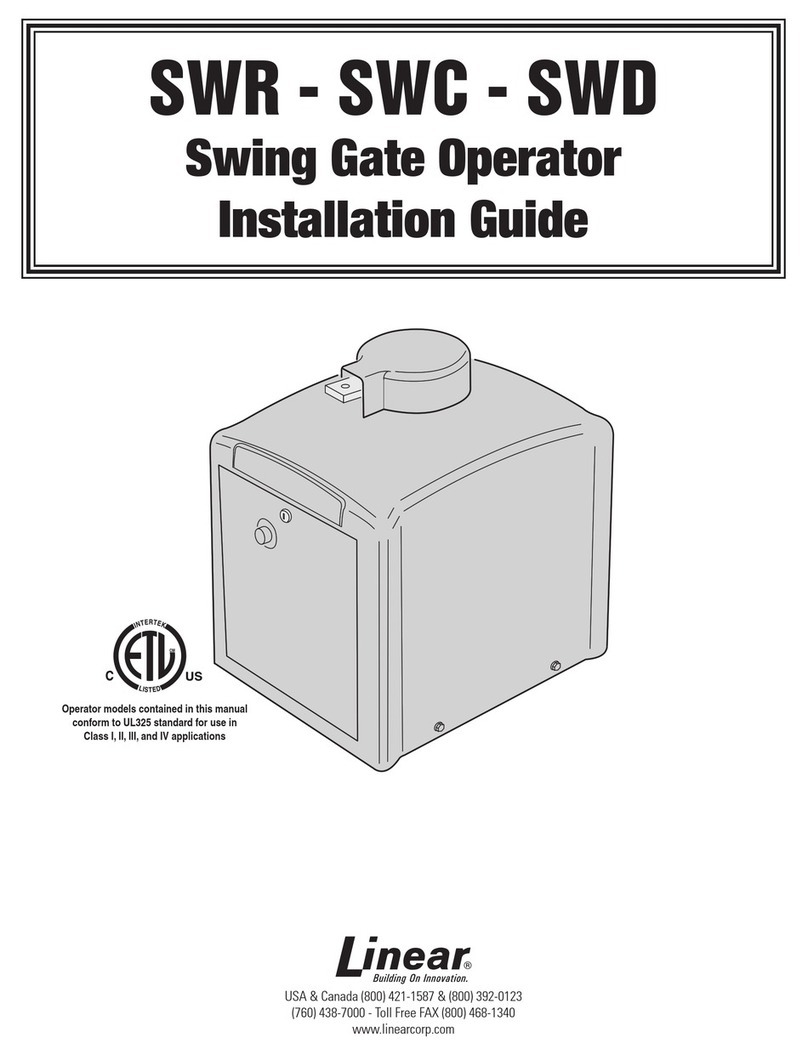
Linear
Linear SWC User manual
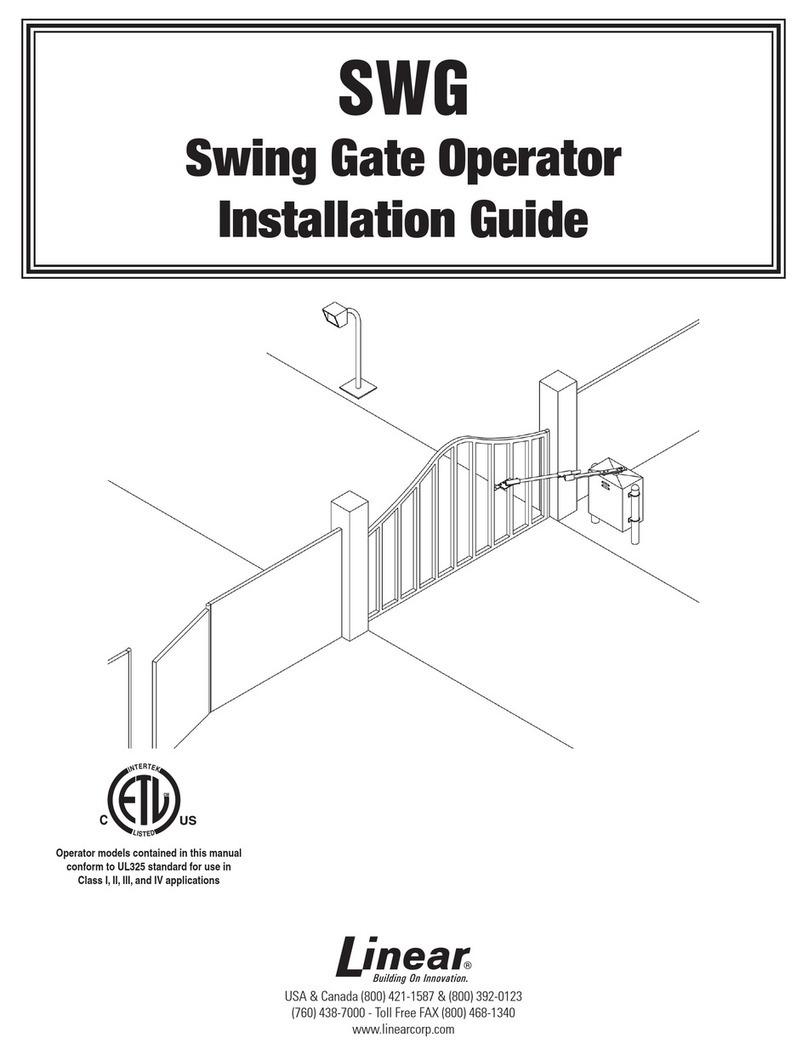
Linear
Linear SWG User manual
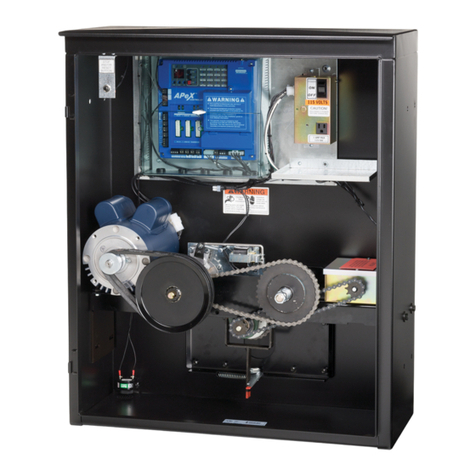
Linear
Linear HSLG User manual

Linear
Linear BGUS User manual
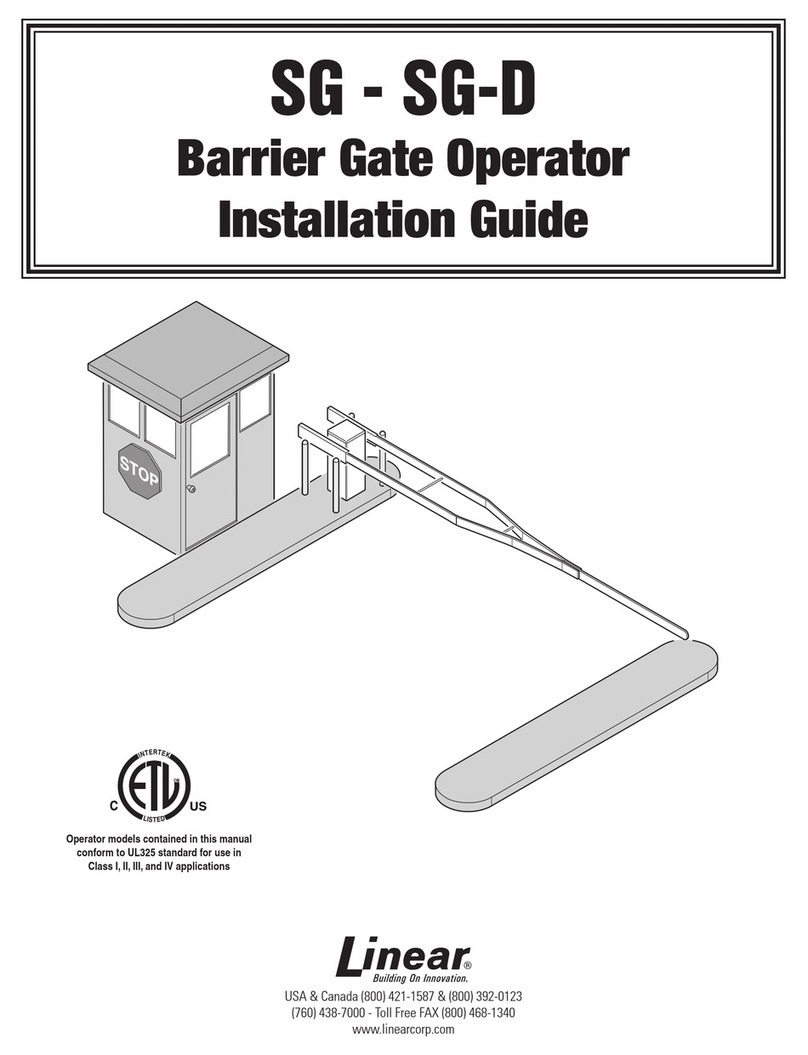
Linear
Linear SG User manual
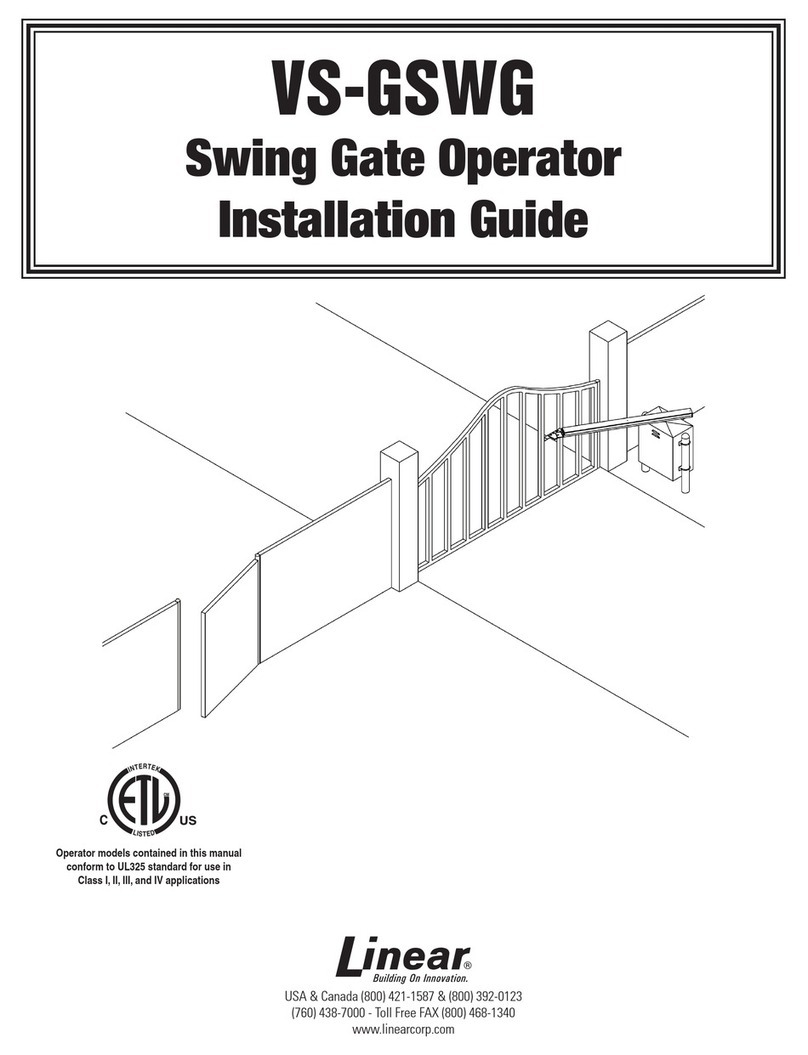
Linear
Linear VS-GSWG User manual
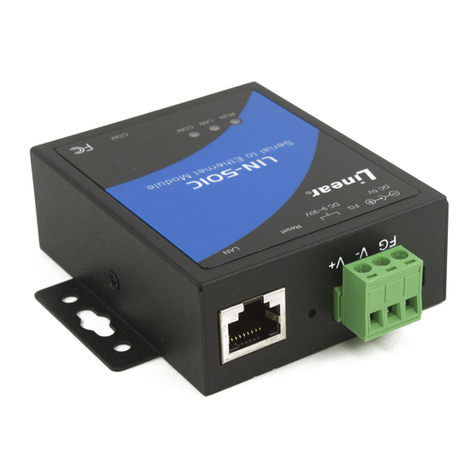
Linear
Linear AM-SEK User manual
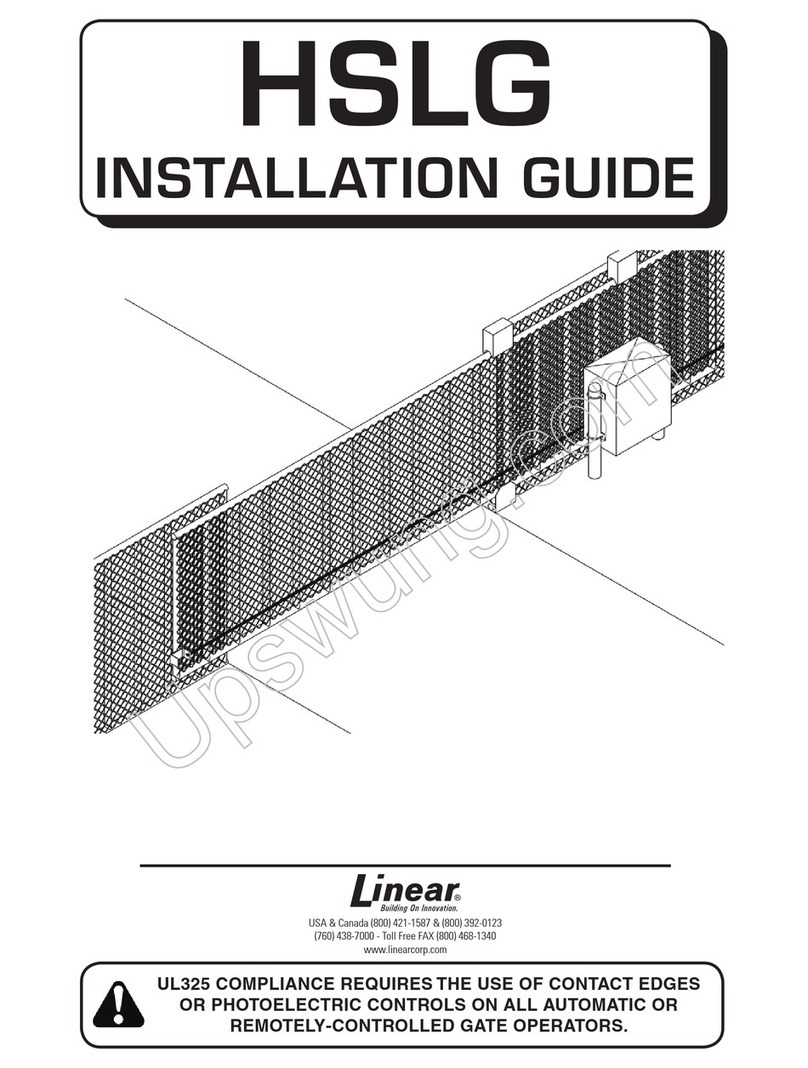
Linear
Linear HSLG-421 User manual

Linear
Linear HSLG User manual
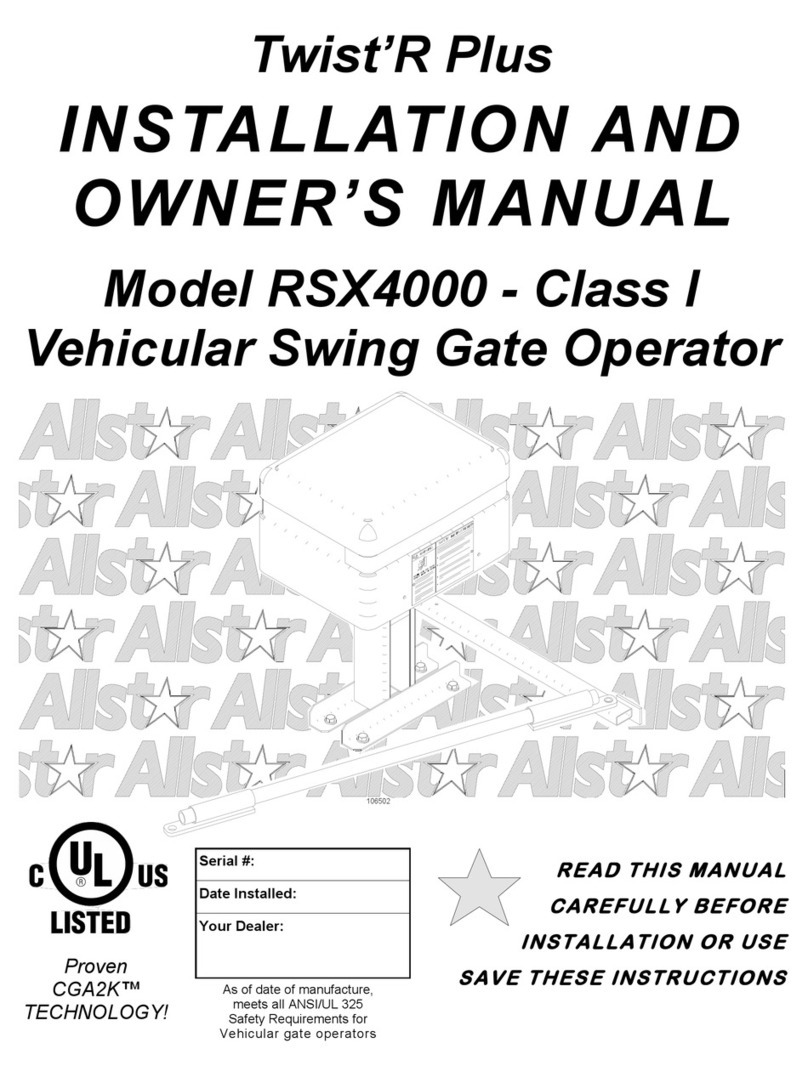
Linear
Linear Twist'R Plus SX4000 User manual
Popular Gate Opener manuals by other brands
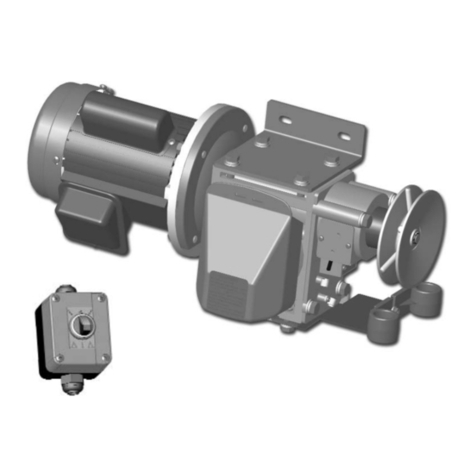
ATA
ATA AXESS 2000 Pro Series installation instructions
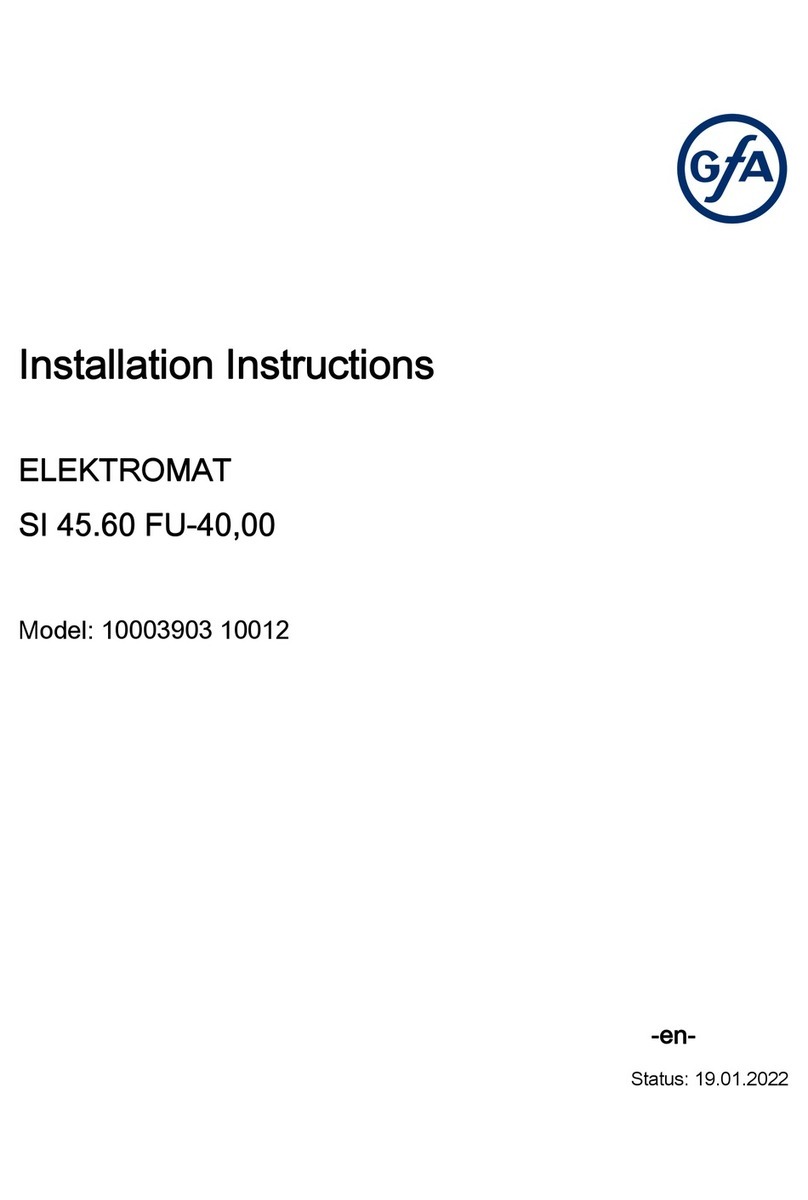
GFA
GFA 10003903 10012 installation instructions
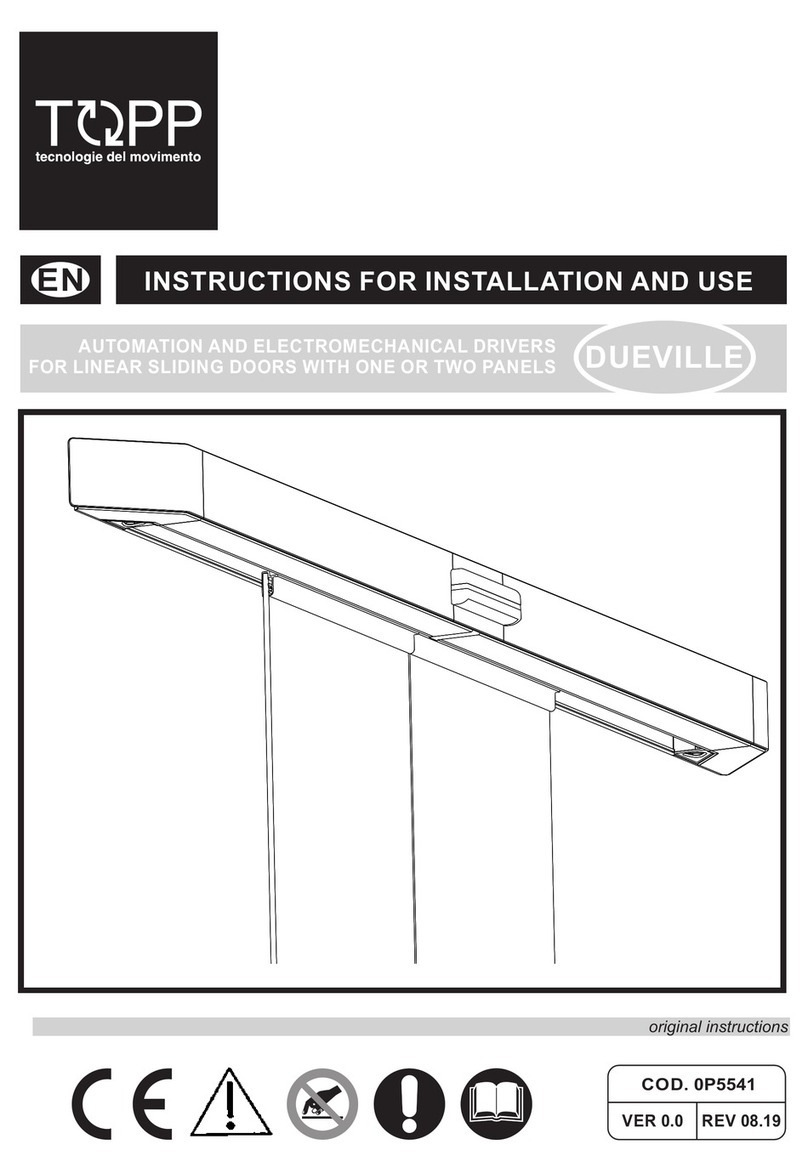
TOPP
TOPP DUEVILLE Instructions for installation and use
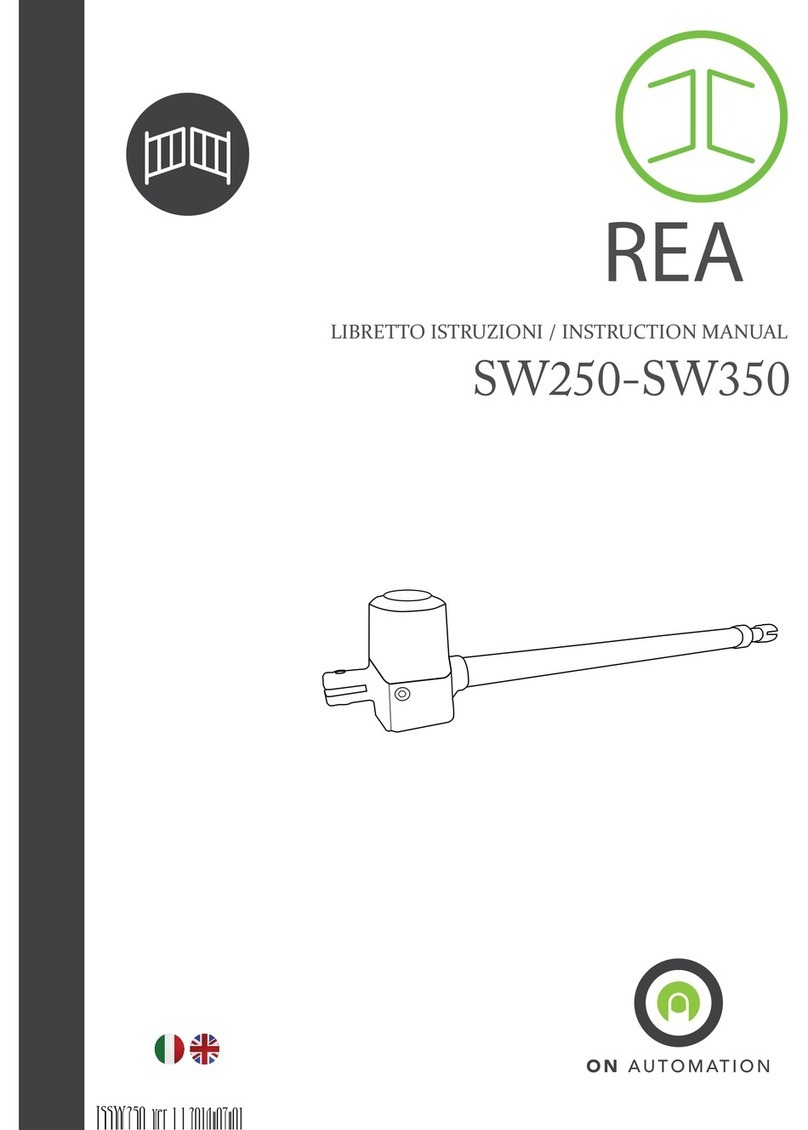
REA
REA SW250 instruction manual
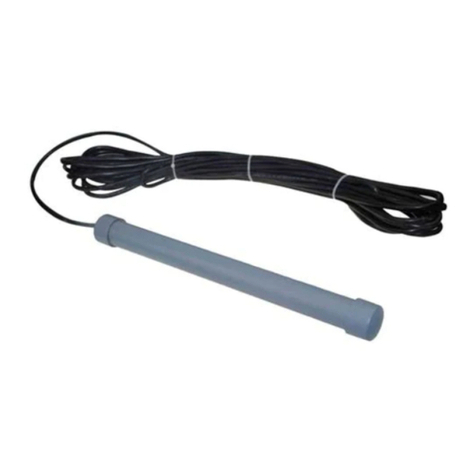
Topens
Topens TEW3 Installation and operation instructions
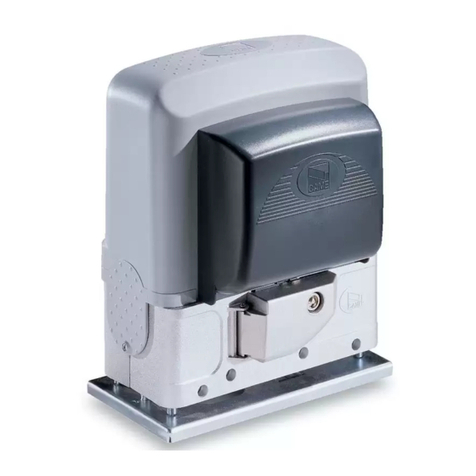
CAME
CAME BK Series Installation, operation and maintenance manual
